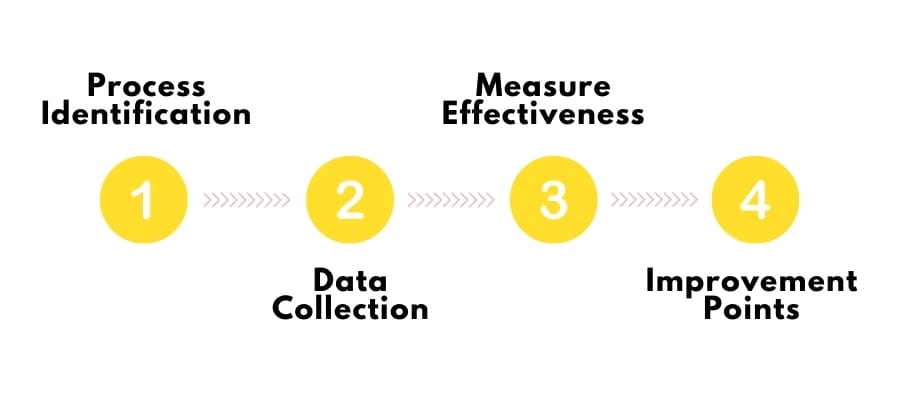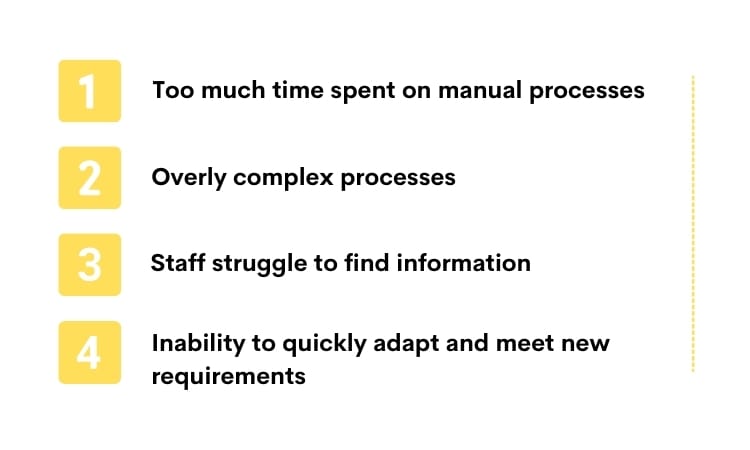“Understanding BPA and key steps for process improvements”
It is not uncommon to see managers, team leads, and business owners spend valuable time trying to identify the reason behind systematic delays, inefficiencies, and inaccuracies. These attempts at root cause analysis, however, are often inefficient and poorly planned, leading to wasted resources and a continued lack of understanding of what could be improved.
What if there was a way to better analyze processes methodically, helping executives introduce better analysis techniques into the company? Enter business process analysis.
What is Business Process Analysis?
According to The United Nations Trade Facilitation and Implementation Guide, Business Process Analysis (BPA) is a methodology for the analysis of a business to understand the processes and improve the efficiency and effectiveness of its operations. It describes the processes involved, parties participating, information exchanged and documents produced.
This methodology allows organizations to better meet business goals in a step-by-step fashion by studying and analyzing techniques and developing better workflows and business rules that allow for enhancements in process mapping. Ultimately, BPA is a process analysis effort that seeks process improvement and increased efficacy.
Regardless of your industry, BPA is a great way to analyze chaotic processes and turn them into thorough guidelines for your employees. Let’s find out how.

 What is the purpose of the business process analysis?
What is the purpose of the business process analysis?
You probably remember a recent Virtus Flow article on the importance of the employee onboarding process — a process that matters now more than ever, as organizations continue evolving in the virtual world. Amongst other goals, through the ever-changing onboarding process companies introduce internal guidelines on how things operate internally, but for this initial step to be successful, these guidelines (or written processes) must be thorough, transparent, and accurate. BPA ensures they are.
A few other benefits of BPA are:
1. Reduction of redundancies
It is common to see processes become redundant or unnecessary as companies expand and shift their goals. This becomes a problem not only for new employees, who aren’t trained to achieve maximum efficiency but also for existing teams and even production, as processes are wasteful and redundant. BPA identifies these redundancies by examining data and helping companies keep what they need.
2. Introduction of new technologies
Similar to redundant processes when companies grow, we often see obsolete processes that don’t account for new technologies. This happens when processes aren’t revisited and analyzed often. A key benefit to BPA is business analysis, as organizations have a step-by-step guide on what data to analyze — leading to processes that take advantage of innovations.
→ Getting rid of manual tasks and repetitive processes with workflow automation technologies
3. Ensuring appropriate use of resources
If processes go long periods without being refreshed, we often fail to realize we’re not making the best use of resources and therefore not reaching our full potential. As a whole, companies must use BPA to ensure processes are efficient, fair, and cost-effective.
4. Mitigate Risk
Staying abreast of potential risk is key for organizations to stay successful. Risk can be economic, compliance, fraud, operational, and reputation related, and when we analyze the process for each of these areas, we’re able to improve processes to mitigate long-term damage to our organization and brand.
→ Case Study: Automation of Compliance and Risk Assessment Controls
5. Promoting transparency
BPA doesn’t only analyze and improve processes that could hurt the organization as a whole, but also allows companies to improve company culture by promoting transparency and defining expectations.
4 Essential Steps of any Business Process Analysis
You now know the benefits of BPA, so let’s help you get started with the four essential steps to follow when analyzing your business process.

The first step of any BPA is determining what process you’ll analyze, the team and stakeholders involved, how this process affects your business goals and whether it adds value to the company.
Consultant Peter Drucker recommends asking five questions to identify processes:
What is our mission?
Who is our client?
What does the customer value?
What are our key results?
What’s our plan?
2. Collect the right data
Once you’ve determined the process to analyze, it’s important to collect as much data as possible to understand issues, key performance indicators, goals and timelines. A good idea is to interview the people involved and get a 360-degree view of role ownership.
This might feel like the longest step in the process, but the more information you gather, the better you’ll be able to assess areas for improvement.
3. Identify As-Is Process
Flowcharts and diagrams are an excellent tool to define the process and measure its effectiveness. Some useful questions to ask as you build your business process analysis workflow are:
-
- What are the most important components of the process?
- Are there any systematic delays or issues in the process?
- Does a particular component of the process require too many resources?
- Is there a way to change it?
4. Specify improvement points
Once you have gathered data to understand the process and have answered all relevant questions to identify areas that need to be updated and improved, it’s time to make a recommendation. Whether the changes are big, small, or the process needs to be reengineered entirely, make sure to map out a plan that includes long-term effects and action items to take.
Improve Business Processes with No-Code Digital Automation
Anyone can do it. No IT skills are needed – No coding – Get to know what takes to digitize and automate your business processes with digital workflows.



 What is the purpose of the business process analysis?
What is the purpose of the business process analysis?












